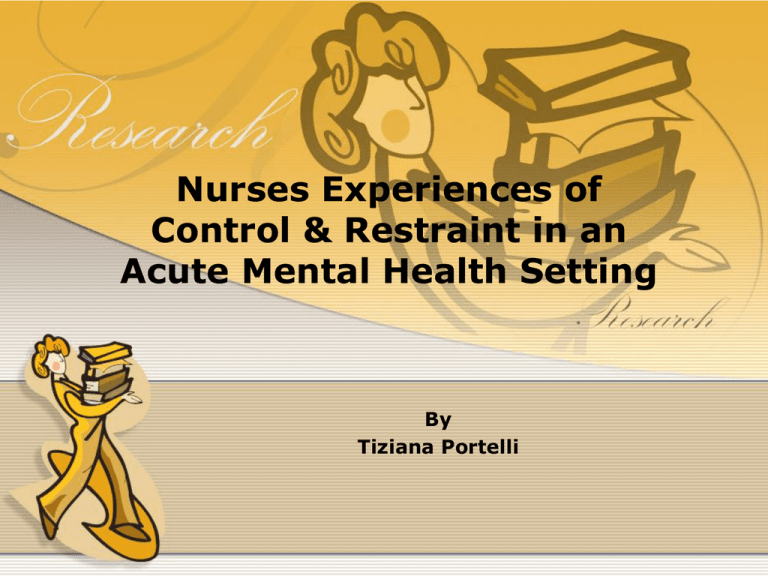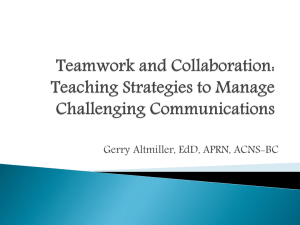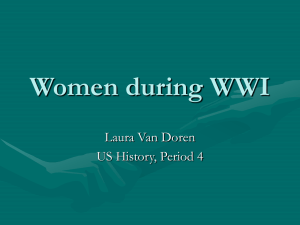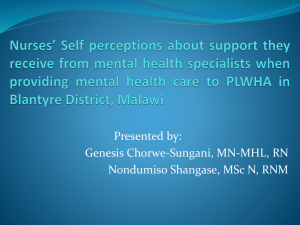Control and restraint in acute psychiatric settings
advertisement

Nurses Experiences of Control & Restraint in an Acute Mental Health Setting By Tiziana Portelli Introduction The overall purpose of this study was to explore nurses’ experiences of control & restraint in an acute mental health setting. Reasons for choosing this topic: • Various researchers report that incidents of violence and threats of violence have shown a considerable increase over the last few years. • Increased number of staff injuries whilst restraining patients. • Personal interest. Aims & Objectives … • Develop a clear picture of how many nurses had any form of training; • Establish the understanding that nurses have about C & R; • Establish when & how C & R should be used; • Establish knowledge of alternatives. Literature Review To identify from the literature: • A definition of control & restraint • When to use it • Managing the process • Alternatives • Published research regarding nurses views & experiences Definition of control & restraint Definitions lack consistency within the literature. (Johnson, 1998) It is an intervention it involves a designated system of techniques. (Anderson et al., 1999) Control & restraint interventions are a common method for managing a range of clinical situations. (Steel, 2000) Methodology • Purposive, mixed method, correlational design; • Population – qualified nurses in acute psychiatric setting; • Sample – all acute wards; • Self designed structured questionnaire; • Data analysis – numerical and thematic. Findings • demographic data • training • control & restraint & other techniques • control & restraint & injuries • post procedures Findings … • Demographics of sample … • n = 56 • fairly evenly distributed sample • majority were staff nurses • 10 of these were RMN’s • Majority had over 6 years service Develop a clear picture of how many nurses had a form of training • Most participants had no training • Those that did, received it after they were already working in acute wards • This could be because a large number of nurses are general trained • Also could be related to lack of resources • There is no hospital policy indicating training as a requirement Establish the understanding that nurses have about C & R • Nurses clearly understood the importance and need for training • This may be because of their experiences and their knowledge that there is a high tendency for patients to become violent & aggressive • A high % felt anxious and lacked knowledge in several key areas Establish when & how C & R should be used • Participants did not have a clear understanding of what it is and when and how it should be used; • Nurses lack de-escalation skills; • Physical restraint is the first choice in nearly all situations; • Staff regularly incur injuries during C&R Establish knowledge of alternatives • Nurses had neither knowledge nor training on alternatives • Local mentality may be significant • Nurses may lack confidence to use other approaches. MAIN CONCLUSION …. • … there is an overwhelming lack of knowledge and training concerning control and restraint amongst nurses working in acute wards within the hospital where this research was conducted. • This fact might then result in the frequent and inappropriate use of control and restraint techniques being applied to patients. Limitations of the study • Results can’t be generalised • Few psychiatric nurse participants • Small scale study • A number of participants' did not comment Strengths of study • Good response rate • Good representation of nurses grade, experience etc • Use of questionnaires proved beneficial. Recommendations • Clinical practice • Education • Management • Further research References … Johnson, M.E. (1998) Being restrained: a study of power and powerlessness. Issues in Mental Health Nursing. 19:191-206 Anderson, L, N., Minarik, P, A., Dilmorth, J, M., Jones, J., Nash, K, P.,O’ Donell, K, P., & Steinmiller,E, A.(1999). Responding to difficult patients. American Journal of Nursing, 99(12), 26-32 Steel, E.(2000). Seclusion and restraint practice standards: a review and analysis.Retrieved October5,2011, from http://www.ncstac.org/index.php?option=com_contentandview=article andid=94%3Asecl Thank you for your attention.





